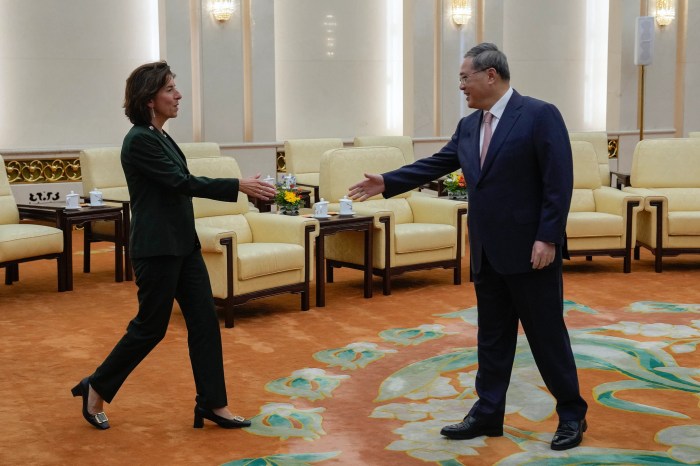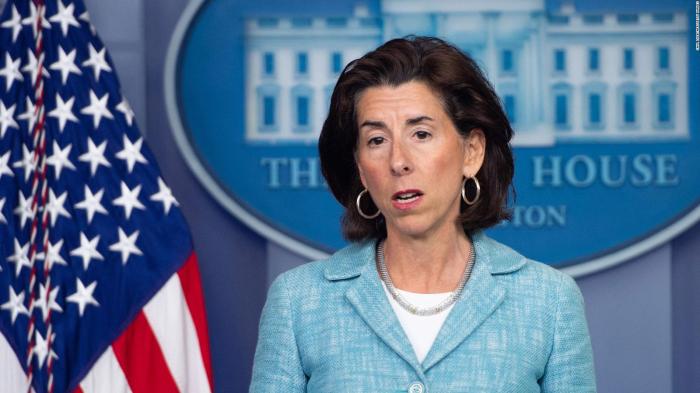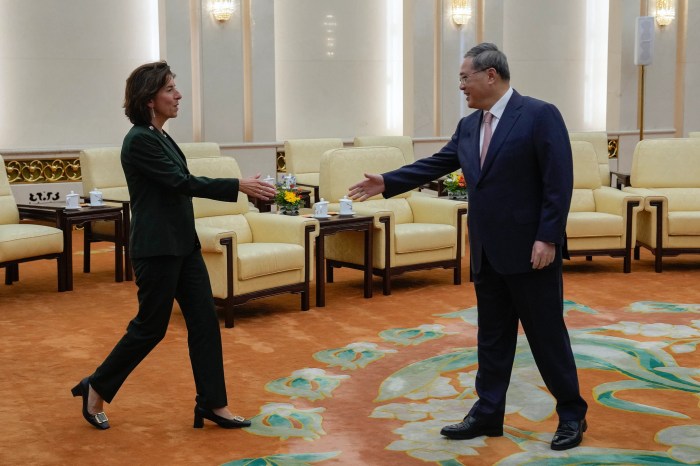
US Commerce Chief Gina Raimondo Meets Chinese Vice Premier in Beijing
US Commerce Chief Gina Raimondo set for important meeting with Chinese vice premier in beijing. This meeting marks a significant moment in the ongoing saga of US-China trade relations. With tensions simmering over issues ranging from technology transfer to intellectual property rights, the stakes are high for both sides.
Raimondo, known for her pragmatic approach, is expected to engage in frank discussions aimed at finding common ground and potentially paving the way for a more stable and collaborative future.
The meeting comes at a time when both countries are grappling with complex economic challenges. The US is navigating inflation and supply chain disruptions, while China faces slowing growth and a shift in its economic priorities. The outcome of this meeting could have far-reaching implications for global trade and the broader geopolitical landscape.
Context and Background

Gina Raimondo, the current US Commerce Secretary, is a prominent figure in the Biden administration’s approach to US-China relations. Her role encompasses overseeing the US Department of Commerce, which plays a crucial role in shaping trade policies, promoting American businesses, and ensuring fair competition in the global marketplace.
The meeting between Gina Raimondo and the Chinese Vice Premier in Beijing takes place amidst a complex and evolving landscape of US-China trade relations. While both countries recognize the interdependence of their economies and the benefits of cooperation, significant tensions exist, stemming from issues such as technology transfer, intellectual property rights, and unfair trade practices.
Key Points of Tension and Cooperation
The current state of US-China trade relations is marked by a mix of cooperation and tension.
- Trade Disputes:The US and China have been engaged in a trade war since 2018, with both sides imposing tariffs on billions of dollars worth of goods. These tariffs have impacted businesses and consumers on both sides, and their removal remains a key priority for both countries.
- Technology Transfer:The US has raised concerns about China’s forced technology transfer practices, which it alleges are unfair and undermine American innovation. This issue has been a major point of contention in trade negotiations and has led to restrictions on Chinese companies’ access to US technology.
- Intellectual Property Rights:The US has also expressed concerns about China’s enforcement of intellectual property rights, arguing that Chinese companies often infringe on US patents and copyrights. This issue has been a significant source of friction between the two countries and has led to calls for stronger protections for US intellectual property in China.
- Market Access:US businesses have faced challenges in gaining access to the Chinese market, with restrictions on foreign investment and discriminatory regulations. The US has sought to address these barriers to market access through trade negotiations and by pressing China to create a more level playing field for foreign companies.
While Gina Raimondo heads to Beijing for critical talks with Chinese leadership, news broke that Daniel Baldwin has joined the team at iSHook , a move that could potentially influence trade negotiations between the US and China. With both sides seeking to navigate complex economic and political landscapes, these developments underscore the interconnected nature of global business and diplomacy.
Significance of the Meeting, Us commerce chief gina raimondo set for important meeting with chinese vice premier in beijing
The meeting between Gina Raimondo and the Chinese Vice Premier is significant because it provides an opportunity for both sides to engage in high-level dialogue and potentially make progress on some of the key issues that have strained US-China relations.
This meeting is particularly important given the recent tensions surrounding Taiwan and the growing competition between the two countries in areas such as technology and semiconductors.
Meeting Objectives and Agenda

The meeting between US Commerce Secretary Gina Raimondo and Chinese Vice Premier He Lifeng is expected to be a crucial step in managing the complex economic relationship between the two countries. Both sides will aim to address critical issues and explore avenues for cooperation, while navigating existing tensions.
Trade Disputes and Economic Relations
The US and China have been engaged in a trade war since 2018, with tariffs imposed on billions of dollars worth of goods. This has disrupted global supply chains and impacted businesses on both sides. The meeting will likely focus on easing these tensions and finding ways to reduce tariffs or reach new trade agreements.
Both sides will aim to understand each other’s perspectives and identify potential areas for compromise.
Technology Transfer and Intellectual Property Rights
The US has expressed concerns over China’s policies on technology transfer and intellectual property rights, alleging forced technology transfer and theft of intellectual property. These concerns have been a major point of contention in the trade negotiations. The meeting will likely address these issues, with the US seeking assurances from China on protecting intellectual property and creating a level playing field for US companies.
Investment and Market Access
US businesses have faced challenges in accessing the Chinese market, with restrictions on foreign investment and concerns about unfair competition. The meeting will likely address these issues, with the US seeking greater market access for US companies and a more transparent investment environment in China.
The stakes are high for US Commerce Secretary Gina Raimondo’s meeting with Chinese Vice Premier He Lifeng in Beijing. As the US and China navigate complex economic and geopolitical challenges, Raimondo’s visit comes at a time of heightened tensions, particularly in the tech sector.
It’s interesting to note that this meeting coincides with a strong day on Wall Street, where US stocks rallied as techs rebounded and the Dow eyed its 10th consecutive win. Whether this positive market sentiment translates into productive discussions between the US and China remains to be seen, but Raimondo’s trip is undoubtedly a critical moment in the ongoing US-China economic dialogue.
China, on the other hand, may seek to attract more US investment and technology.
Potential Outcomes
The meeting could lead to a number of outcomes, including:
- A commitment to de-escalate trade tensions and explore potential trade deals.
- Agreements on specific issues, such as intellectual property rights or market access.
- Increased dialogue and cooperation on economic matters.
- A roadmap for future discussions and negotiations.
Key Issues and Challenges
This meeting presents a crucial opportunity to address longstanding trade tensions and explore potential avenues for cooperation. However, several key issues and challenges could hinder progress.
Potential Impact on Specific Industries
The meeting’s outcome could significantly impact various industries, particularly technology, manufacturing, and agriculture.
With Gina Raimondo, the US Commerce Chief, heading to Beijing for a critical meeting with China’s Vice Premier, the economic landscape between the two superpowers is certainly a hot topic. While the meeting will likely focus on trade tensions and technology, it’s worth noting that US consumer sentiment is on the rise, as reported in the University of Michigan survey , which suggests a more optimistic economic outlook for American consumers.
This could potentially influence the tone and direction of Raimondo’s discussions, particularly regarding consumer goods and trade agreements.
- Technology: The US-China trade war has already impacted the technology sector, with tariffs imposed on semiconductors, telecommunications equipment, and other high-tech goods. The meeting could lead to discussions on reducing these tariffs or establishing new trade agreements for technology products.
- Manufacturing: The manufacturing sector has been heavily impacted by the trade war, with tariffs on goods like automobiles, machinery, and consumer electronics. The meeting could lead to discussions on reducing these tariffs or exploring ways to enhance supply chain cooperation.
- Agriculture: The US agricultural sector has been significantly impacted by the trade war, with tariffs imposed on soybeans, pork, and other agricultural products. The meeting could lead to discussions on reducing these tariffs or exploring new markets for US agricultural exports.
Possible Outcomes and Implications: Us Commerce Chief Gina Raimondo Set For Important Meeting With Chinese Vice Premier In Beijing
The meeting between Gina Raimondo and the Chinese vice premier holds significant implications for US-China relations, particularly in the realm of trade and business. The potential outcomes of this meeting could range from positive steps towards resolving existing trade disputes to further escalation of tensions.
Potential Outcomes of the Meeting
The potential outcomes of the meeting can be categorized into three scenarios:
- Positive Outcome:The meeting could lead to a breakthrough in resolving some of the key trade disputes between the US and China. This could include agreements on specific issues like intellectual property protection, market access for US businesses, and technology transfer.
Such a positive outcome would likely involve both sides making concessions and demonstrating a willingness to compromise. This could potentially lead to a more stable and predictable trade relationship between the two countries.
- Stalemate:The meeting could result in a stalemate, with neither side willing to make significant concessions. This would likely lead to the continuation of existing trade tensions and the potential for further escalation. The lack of progress could also create uncertainty for businesses operating in both countries.
- Negative Outcome:The meeting could lead to further deterioration of US-China relations. This could involve the imposition of new tariffs or other trade restrictions by either side. Such a negative outcome would likely have a significant impact on global markets and could lead to a global economic slowdown.
Implications for US and Chinese Businesses
The outcome of the meeting will have a direct impact on businesses operating in both countries.
- Positive Outcome:A positive outcome could lead to increased trade and investment between the US and China, benefiting businesses in both countries. This could include greater access to the Chinese market for US businesses and greater opportunities for Chinese businesses to invest in the US.
- Stalemate:A stalemate would likely lead to continued uncertainty and volatility in the business environment for both US and Chinese businesses. This could make it difficult for businesses to plan for the future and could lead to a decline in investment and trade.
- Negative Outcome:A negative outcome could lead to significant disruptions in the supply chains of both US and Chinese businesses. This could lead to higher prices for consumers and could also lead to job losses in both countries.
Impact on Future US-China Trade Negotiations and Policy
The meeting could set the stage for future US-China trade negotiations and policy.
- Positive Outcome:A positive outcome could create a more constructive environment for future trade negotiations. This could lead to a more stable and predictable trade relationship between the two countries.
- Stalemate:A stalemate could make future trade negotiations more difficult. This could lead to a further escalation of trade tensions and could make it more difficult to reach a comprehensive trade agreement.
- Negative Outcome:A negative outcome could lead to a further deterioration of US-China relations and could make it more difficult to resolve existing trade disputes. This could also lead to a more protectionist trade policy in both countries.
Expert Opinions and Perspectives
The upcoming meeting between Gina Raimondo, US Commerce Secretary, and Chinese Vice Premier He Lifeng in Beijing has garnered significant attention from experts across various fields. Their insights offer valuable perspectives on the potential outcomes and implications of this high-level engagement for US-China trade relations.
Expert Views on US-China Trade Relations
The meeting presents a critical opportunity to address longstanding trade disputes and explore potential areas for cooperation. Leading economists, political analysts, and business leaders have offered diverse perspectives on the key issues at stake.
- Dr. Edward Alden, Senior Fellow at the Council on Foreign Relations:“The meeting is a chance to stabilize the relationship and avoid further escalation. Both sides need to understand that decoupling is not in anyone’s best interest.” Alden emphasizes the need for both countries to prioritize dialogue and cooperation to prevent further economic and geopolitical instability.
- Dr. Mary Lovely, Senior Fellow at the Peterson Institute for International Economics:“While there are areas of potential cooperation, such as climate change and global health, the fundamental differences on technology, intellectual property, and market access remain.” Lovely highlights the challenges in achieving meaningful progress, given the deep-seated structural issues that have long plagued the US-China trade relationship.
- Mr. Michael Pillsbury, Former White House National Security Advisor:“China is playing a long game and will continue to pursue its own interests, regardless of the outcome of this meeting. The US needs to be prepared for a protracted strategic competition.” Pillsbury expresses a more cautious outlook, emphasizing the ongoing strategic competition between the two countries and the need for a long-term perspective.
Global Implications of the Meeting
The meeting’s potential impact extends beyond the bilateral relationship, influencing global trade patterns and geopolitical dynamics.
- The World Trade Organization (WTO):The WTO has expressed concerns about the increasing trade tensions between the US and China, urging both countries to adhere to international trade rules and avoid protectionist measures. The meeting’s outcome could have significant implications for the WTO’s role in regulating global trade.
- European Union (EU):The EU has called for a “level playing field” in trade with China, expressing concerns about unfair competition and intellectual property theft. The EU is closely watching the meeting’s outcome, hoping for a resolution that promotes a more balanced and predictable trade environment.
- Emerging Economies:Developing countries are particularly vulnerable to the economic fallout from US-China trade tensions. The meeting’s success in stabilizing the relationship could have a positive impact on global economic growth and development.

